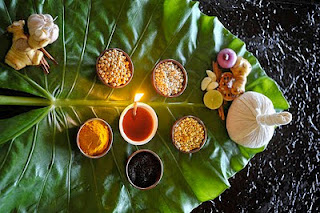1
Sadhak pitta
Sadhak pItta is found in the brain and heart. It governs well being, concentration, trust, courage, daring, initiative, desires, creative originality and self-belief. It provides strength to the heart, increase of intellect/discrimination, intelligence, rational thought and pride (in the sense of healthy self-esteem and dignity). When Sadhak pitta is functioning properly it is said that a person is easily able to achieve the four purushártha, that is,´objects of human pursuit´ - dharma (duty), artha (financial status), káma (desires) and moksha (liberation from the wheel of life and death).
Ayurveda
itself, by preserving and healing the body, mind and spirit, exists to enable us
to pursue these worthy goals of our precious human lives. Where else do we
live? From where do we act? ´The body is
the greatest dharma´ means that we inevitably experience this life, with its
pleasures, pains and challenges, while incarnated in a physical body, thus we
can see the vital importance of Sadhak Pitta. When the intellect is clouded, when
courage and/or self belief are in short supply and when self- esteem is low, we
lack the mental and emotional resources to fulfill our purushártha.
2
Alochak pitta
Alochak pitta is located in the eyes and governs vision. It can be compared with rhodopsin and iodopsin. rods and cones, although this is not an exact correlation and we must remember that pitta should rather be considered an energetic function. Alochak pitta interprets the visual stimuli of light and colour, converting electrical impulses into vision that can be understood and read by the brain. It processes and assimilates information. It has been argued that Alochak pitta governs internal as well as external vision, ie the Third eye or pineal gland but this question is moot.
3
Pachak pitta
Pachak Pitta is located in the stomach, duodenum and small intestine. It is responsible for the digestion of food through metabolic activity into nutritional gastric juices, that is ,all the enzymatic and pancreatic juices. Pachak pitta is responaible for the formation of other types of pitta in the body and is therefore of the utmost importance.
4
Bhrajak pitta-
Bhrajak Pitta is found in skin tissue. One of its functions is to absorb whatever may be applied to skin through the pores, including the herb infused oils and ointments that need to reach deeper tissues. It also provides glow, aura, and brightness of the skin. It regulates skin and body temperature within defined parameters through sweating.
5
Ranjak pitta
Ranjak pitta is found in the liver, another seat of pitta. It converts rasa (first digested product) into rakta (blood). yakrit (liver), pliha (spleen), amashaya (stomach) and hridya (heart). forming blood cells. Ranjak pitta determines the colour of twak (skin), kesh (hairs) and netra (eyes). Ranjak pitta in the small intestines imparts color to urine and stools, which are importat to diagnosis in astavidha pariksha, the eightfold examination.
Normal functions of pitta
Normal
digestion of food, metabolism and elimination, normal formation of blood,
maintenance of temperature, sweating function, shine and glow of skin, proper
vision, ie converting images accurately.
Normal mental functions
Enthusiasm,
self-confidence, courage, happiness, emotional balance, self expression, bravery,
feelings of well-being, happiness and courage, confidence, integrity, endorphins,
love of life, decisiveness.
Abnormal functioning
Burning
sensation, infections, external or internal inflammation, disturbed digestion,
hyper-acidity, gastric acid reflux disorder, piles, any bleeding disorders,
ulcers, herpes, diarrhoea, anger, burnout, disturbed
sleep, disturbed vision, hepatitis, jaundice, acne, pimples, irritation,
urinary tract infections, gallbladder problems, red burning eyes, pancreatitis,
excessive hunger or thirst, discolouration of skin, or waste products, reduced
or excessive production of hormones and enzymes is also seen.
Ultimately
the very production of pitta dosha is affected and the body may become cold and
dry.
Abnormal mental functioning
Anger,
overconfidence, violence, extremism, jealousy, competition, irritation, feelings
of hatred, aggression or the reverse, loss of self-confidence, self esteem and
drive..
What aggravates Pitta?
Pitta
is aggravated by smoking, citrus fruits, alcohol, coffee, chocolate, hot and
pungent spices, mustard oil, burning, stimulants, fighting, sun, central
heating, mental tensions, austerities, and whatever is hot in nature. Strong
emotions, such as anger, feelings of competition, pride, envy, revenge, also
aggravate pitta, so we can see anger and other ´hot´ emotions as both cause and consequence of deranged
pitta dosha.
What
soothes Pitta?
Cooling
treatments, such as takradhara, shiroabhyangam
with cooling, oil spending times near bodies of water, such as lakes or
reservoirs, waterfalls, time in nature, sleeping on rooftops, eating foods
whose nature is cooling, sweet, bitter and astringent tastes, such as fruit,
green leaves or tea, or tridoshic, such
as ghee and lavana, spending time
with loved ones and friends in a relaxing, non-competitive atmosphere, the
practice of cooling pranayama breathing
techniques or hatha yoga (not ashtanga) , gentle exercise and
meditation.
